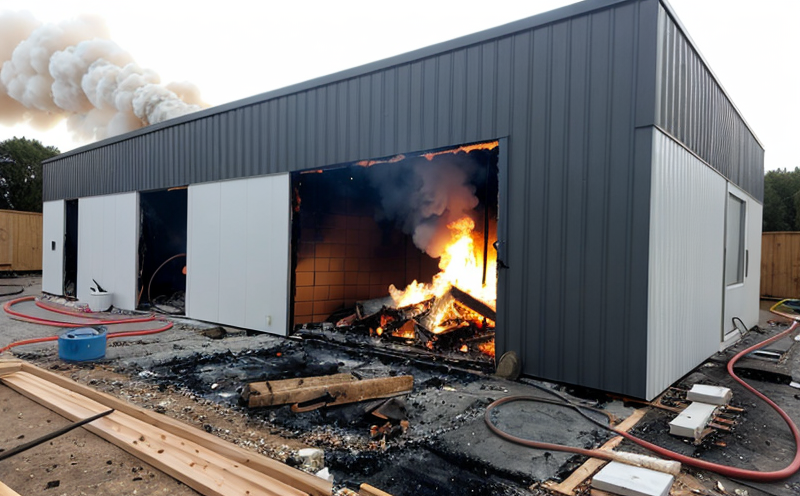EN 13823 SBI Test – Single Burning Item Test
The EN 13823 SBI test, also known as the Single Burning Item (SBI) test, is a critical component in fire safety testing for building materials and components. This standardized procedure assesses the combustion behavior of insulation materials used on external walls and claddings under controlled laboratory conditions.
The SBI test evaluates how insulation materials perform when exposed to an open flame. The primary objective is to determine if the material will spread flames, melt, or produce toxic fumes that could contribute to a fire hazard in buildings. This test ensures compliance with European Union regulations aimed at reducing the risk of fire in residential and commercial properties.
The test setup involves placing a sample specimen onto an inclined wall section within a specially designed combustion chamber. The specimen is exposed to an open flame for 10 minutes, after which it is allowed to self-extinguish. During this process, various parameters are measured, including the rate of heat release, smoke production, and the formation of toxic gases.
The results from the SBI test are crucial in assessing the fire resistance properties of insulation materials. Compliance with EN 13823 ensures that building products meet stringent safety standards, thereby protecting occupants and structures against potential fire risks. This standard is particularly important for architects, engineers, and construction professionals involved in specifying and selecting appropriate insulation materials.
The SBI test plays a vital role in the broader context of fire safety testing within the construction industry. It complements other tests such as the BS 8414 and EN 13501-1 which focus on different aspects of fire performance.
In summary, the EN 13823 SBI test is a fundamental tool for ensuring that insulation materials used in external wall and cladding systems meet critical fire safety standards. By providing reliable data on material behavior under specific fire conditions, this standardized procedure helps ensure safer construction practices across Europe.
- Compliance with European Union regulations: Ensures adherence to strict fire safety requirements.
- Evaluation of combustion behavior: Measures how materials react when exposed to open flames.
- Assessment of heat release and smoke production: Provides insights into the potential risks associated with the use of insulation materials.
- Promotion of safer building practices: Helps architects, engineers, and constructors make informed decisions about material selection.
Scope and Methodology
The scope of the EN 13823 SBI test is specifically focused on evaluating the fire performance of insulation materials used in external walls and cladding systems. This includes a wide range of products such as expanded polystyrene (EPS), extruded polystyrene (XPS), polyurethane foam, and mineral wool.
The methodology for performing the SBI test is detailed in EN 13823. The procedure involves several key steps:
- Sample preparation: Specimens are cut to standard dimensions (typically 50 cm x 50 cm x thickness of the material).
- Placement in combustion chamber: The specimen is mounted on an inclined wall section within a specially designed combustion chamber.
- Application of flame: An open flame is applied to one end of the specimen for 10 minutes. The flame source must be at least 50 mm from the sample and maintained at a temperature between 700°C and 830°C.
- Observation of behavior: During the test, various parameters are recorded, including heat release rate, smoke production, and the formation of toxic gases. The specimen is allowed to self-extinguish after the flame is removed.
- Evaluation criteria: The results are analyzed against predefined acceptance criteria to determine compliance with the standard.
The SBI test provides valuable data that can be used to improve the fire resistance of insulation materials. This information is crucial for developers and manufacturers looking to enhance product safety and performance.
Benefits
- Enhanced fire safety: Ensures that building materials meet stringent European Union regulations, reducing the risk of fire in residential and commercial properties.
- Informed decision-making: Provides architects, engineers, and construction professionals with reliable data on material behavior under specific fire conditions.
- Compliance assurance: Helps ensure that products are compliant with international standards such as EN 13823, which is crucial for regulatory compliance.
- Risk minimization: By identifying potential fire hazards early in the development process, this test helps minimize risks associated with the use of insulation materials.
- Improved product performance: The insights gained from the SBI test can be used to improve the design and composition of insulation materials for better fire resistance.
- Cost savings: Early identification of non-compliant materials can prevent costly rework or product recalls later in the development process.
- Increased market competitiveness: Compliance with international standards like EN 13823 enhances a company's reputation and marketability, particularly within the European Union.
- Promotion of safer building practices: By ensuring that insulation materials meet fire safety requirements, this test contributes to the overall safety and well-being of occupants in buildings.
Customer Impact and Satisfaction
The EN 13823 SBI test has a significant impact on both customers and end-users. For quality managers, compliance officers, and R&D engineers, this standardized procedure provides peace of mind knowing that the insulation materials they specify meet strict fire safety standards.
For architects and engineers, the results from the SBI test offer valuable data that can be used to design safer buildings. This information helps them make informed decisions about material selection, ensuring that the chosen products will perform reliably under fire conditions.
The benefits extend beyond just compliance with regulations. By using insulation materials that pass the SBI test, construction companies and developers can enhance their reputation for delivering high-quality, safe projects. This can lead to increased customer satisfaction and loyalty, as well as a better understanding of how their products contribute to overall building safety.
For end-users, such as tenants and occupants of buildings, the EN 13823 SBI test ensures that they are living in environments where fire risks have been minimized. This can lead to greater confidence in the safety of their homes or workplaces, contributing to a better quality of life.





